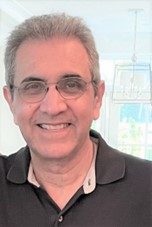Seeing Through Walls: An Electromagnetic Perspective (for general audience)
The ability of electromagnetic waves to penetrate through various building materials, together with advances in design of ultra-wideband compact radar modules, has made see-thru-wall technology, also known as Through-the-wall radar imaging (TWRI), of increasing importance in a wide range of both civilian and defense applications. In this lecture, an overview of various TWRI technologies, including the latest research in several areas important in the design of TWRI systems, will be presented. Electromagnetic-based techniques for wall parameter estimation to mitigate the adverse wall effects and enhance the efficient imaging and classification of targets within and/or behind walls will be discussed. For efficient imaging, details of fast polarimetric and tomographic based imaging algorithms for both 2D and 3D scenarios will be given, and imaging results for various realistic scenarios using both numerical simulations and laboratory measurements will be presented, Development of wideband and ultrawideband antenna arrays, which are essential in successful implementation of see-thru-wall technology, together with hardware descriptions of two constructed portable systems will conclude the presentation. Throughout, I will include a personal perspective from my own two-decade journey in this interdisciplinary research area.
Date and Time
Location
Hosts
Registration
-
 Add Event to Calendar
Add Event to Calendar
- B 600.16, la Galerie Rolland
- 2500 Chem. de Polytechnique
- Montréal, Quebec
- Canada H3T 1J4
- Building: Pavillon Principal
Speakers
 Prof. Ahmad Hoorfar of Villanova University
Prof. Ahmad Hoorfar of Villanova University
Prof. Ahmad Hoorfar
Biography:
Ahmad Hoorfar is a professor of electrical and computer engineering, the ECE department’s graduate chair, and the founder and director of Antenna Research Laboratory at Villanova University. He received his B.S. in electronics engineering from the University of Tehran and the M.S. and Ph.D. degrees in electrical engineering from the University of Colorado Boulder, His research contributions over the years have covered areas in electromagnetic field theory, numerical electromagnetics,
multifunction printed and low-profile antennas, metamaterial media and surfaces, inverse scattering, microwave sensing and imaging, and stochastic optimization methods. He has been a pioneer in development and applications of evolutionary and global algorithms in electromagnetics, development of electromagnetic-based techniques for through-the-wall radar imaging (TWRI) and ground penetrating radar (GPR), compressive sensing applied to GPR and TWRI, and the use of the mathematical concept of space-filling curves in design of electrically small antennas, RFID tags, artificial magnetic conductors, and metasurfaces.
Dr. Hoorfar was the recipient of Villanova University’s Outstanding Faculty Research Scholar Award in 2007, and the recipient of Philadelphia section’s ‘IEEE chapter of the year award' for his leadership in chairing the AP/MTT joint chapter in 1995. His students have won top prizes in student best paper competitions at several IEEE and other international symposia, He has served on the review board of various IEEE and other technical publications, and has also been on the technical program committees of numerous international symposia and conferences on antennas, microwaves, radar, and remote sensing in the last thirty years. He spent his sabbatical leaves in 2002 and 2009 at NASA’s Jet Propulsion Laboratory (JPL) in Pasadena, California, where he contributed to the development of a general optimization code for design of feed horns for NASA’s deep space communication network.
Dr. Hoorfar is a Life Fellow member of IEEE, a member of International Radio Science Commission B, and an elected member of the Franklin Institute Committee on Science and the Arts. He is a Distinguished Lecturer of the IEEE Antennas and Propagation Society (AP-S) for 2023-2025 and has also been serving as the chair of the 2023 IEEE AP-S paper award committee.
Email:

